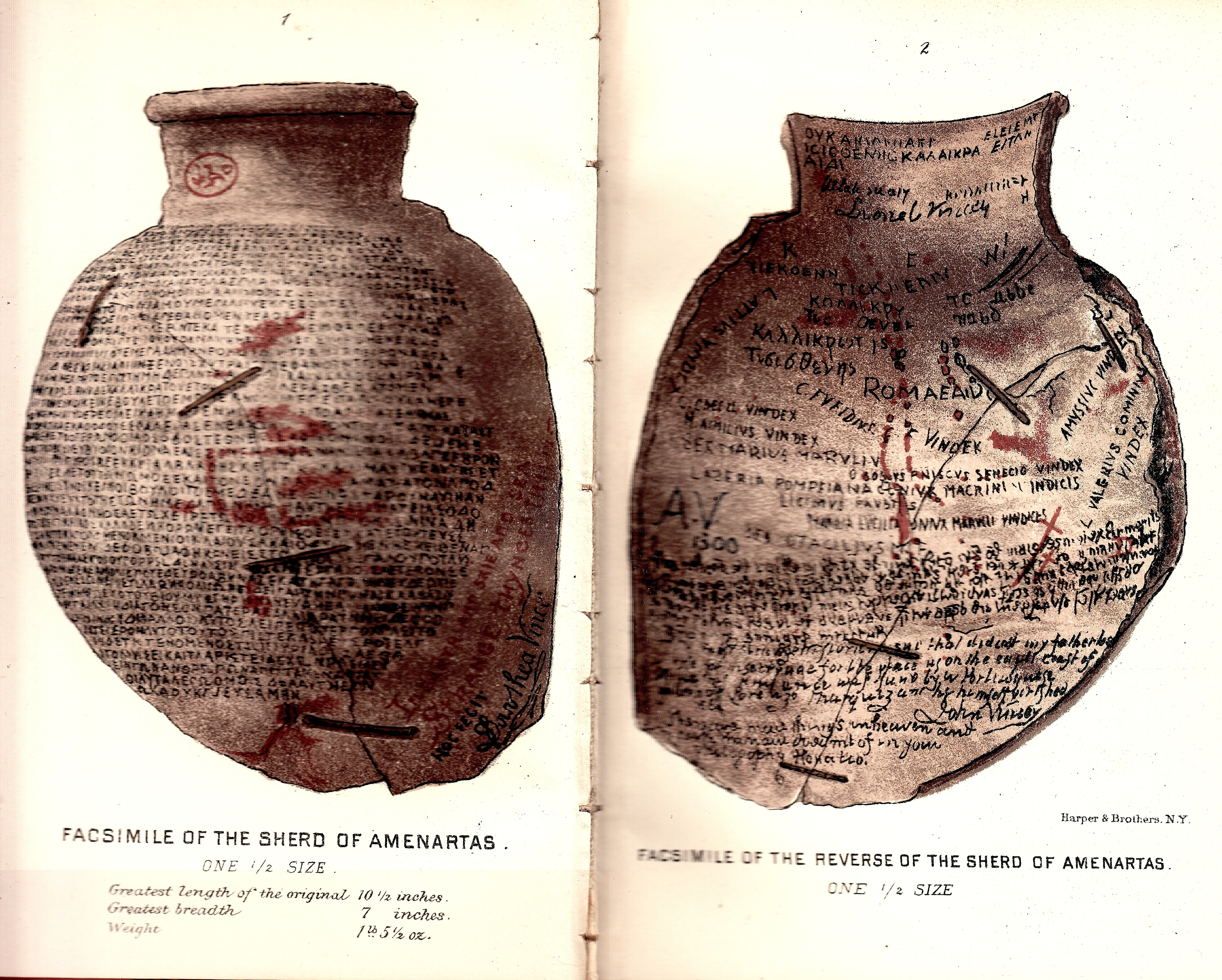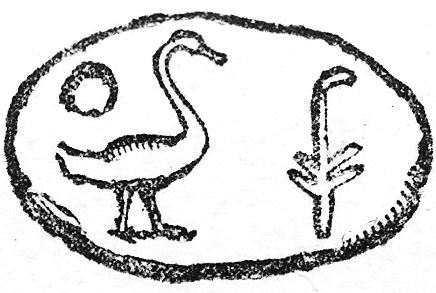
“Facsmile of the Sherd of Amenartas, One-half Size.” and “Facsmile of the Reverse of the Sherd of Amenartas, One-half Size.” (frontispiece), chromolithograph adapted from a pair of composite woodblock illustrations by Edward Killingworth Johnson, R. W. S., in H. Rider Haggard's "SHE:" A History of Adventure, each 4 ⅞ by 3 ¾ inches (12.1 cm high by 9.4 cm wide). The Graphic (9 October 1886): Volume XXXIV, p. 390, vignetted. [Click on the image to enlarge it.]
Passage Anticipated: The Casket — Twenty Years after the Opening Instalment

Right: Maurice Greiffenhagen's volume illustration of the scene in which Holly and Leo finally open the casket: The Casket (1888).
The Description of the Sherd of Amenartas
I handed the letter to Leo, who glanced at the envelope, and then put it down upon the table, making a motion to me to go on emptying the casket.
The next thing that I found was a parchment carefully rolled up. I unrolled it, and seeing that it was also in Vincey’s handwriting, and headed, “Translation of the Uncial Greek Writing on the Potsherd,” put it down by the letter. Then followed another ancient roll of parchment, that had become yellow and crinkled with the passage of years. This I also unrolled. It was likewise a translation of the same Greek original, but into black-letter Latin, which at the first glance from the style and character appeared to me to date from somewhere about the beginning of the sixteenth century.

Left: E. K. Johnson's inset illustration in the serial: "Out of the bag we took first a very beautiful miniature done in ivory, and secondly a small chocolate-coloured composition scarabaeus. . . ." (9 October 1886).
Immediately beneath this roll was something hard and heavy, wrapped up in yellow linen, and reposing upon another layer of the fibrous material. Slowly and carefully we unrolled the linen, exposing to view a very large but undoubtedly ancient potsherd of a dirty yellow colour! This potsherd had in my judgment, once been a part of an ordinary amphora of medium size. For the rest, it measured ten and a half inches in length by seven in width, was about a quarter of an inch thick, and densely covered on the convex side that lay towards the bottom of the box with writing in the later uncial Greek character, faded here and there, but for the most part perfectly legible, the inscription having evidently been executed with the greatest care, and by means of a reed pen, such as the ancients often used. I must not forget to mention that in some remote age this wonderful fragment had been broken in two, and rejoined by means of cement and eight long rivets. Also there were numerous inscriptions on the inner side, but these were of the most erratic character, and had clearly been made by different hands and in many different ages, and of them, together with the writings on the parchments, I shall have to speak presently. [pp. 33-34 in volume]
Commentary: Haggard's Ingenious Bilingual Contrivance, "The Sherd of Amenartas"
The illustrations of the sherd in the Longmans edition of 1887 were photographs of a vase of antique appearance that Haggard's sister-in-law, Agnes Barber, made for him. As the footnotes [in the Penguin edition] indicate, Haggard got help from two classical scholars in composing the Greek and Latin inscriptions on the sherd. [Brantlinger, xxxvii]
The remains of a jar with two handles contain vital clues about the location of the realm of She-who-must-be-obeyed. To ensure that the Greek inscription would withstand the scrutiny of readers with more than a little classical Greek, Haggard had his former headmaster at Ipswich Grammar School, Dr. Hubert Holden, compose that part of the inscription. Stauffer's note on the significance of the sherd contends that it sets up the whole plot:
the ancient "sherd of Amenartas" stands at the heart of the plot as another "wonderful" written text or narrative that requires interpretation. When the novel was published in book form [1887] Haggard had a "fake" sherd fabricated to the specifications of the story, and had photogravure images of it inserted as a frontispiece. . . ; he also greatly augmented the historical transcriptions from the ancient sherd (see Appendix E). In December of 1887, he confessed to his friend H. A. Holden, who helped write the Greek inscriptions on the sherd, that he meant to fool the experts: "I am not without hopes of getting a rise or two of the antiquarians" (UCLA 418.2.5). Indeed, archaeological desires shape this "history" throughout, from the unwrapping of the sherd to the exploration of Kôr and its mummy-filled catacombs, episodes that evoke the experience of reading the novel itself. [Stauffer, 13]
By 1896 Haggard had made some four hundred (generally modest) amendments to the novel, many of which involve Holly's editorial notes: "Most of the additions involve transcriptions and elaborations of the material written upon or included with the Sherd of Amenartas" (Stauffer, "Appendix E: Major Revisions for the First English Edition [1887]," 343).
Related Resources
- A Gallery of Composite Woodblock Engravings for "SHE:" A History of Adventure by Ernest Killingworth Johnson in the Graphic, Vol. XXXIV (1887)
- A Gallery of Lithographic Engravings for SHE: A History of Adventure by Maurice Greiffenhagen in the First British Volume Edition (1887)
Scanned images and text by Philip V. Allingham. [You may use the images without prior permission for any scholarly or educational purpose, as long as you (1) credit the person who scanned them, and (2) link your document to this URL in a web document or cite the Victorian Web in a print one.]
Bibliography
Brantlinger, Patrick. Introduction. She: A History of Adventure. By H. Rider Haggard. London: Penguin, 2004. vii-xxviii.
Haggard, H. Rider. "SHE:" A History of Adventure. Illustrated by E. K. Johnson. The Graphic Magazine, Vols. XXXIV and XXXV. 2 October 1886 to 8 January 1887.
Haggard, H. Rider. SHE: A History of Adventure. Illustrated by E. K. Johnson. New York: Harper & Bros., 1887.
Haggard, H. Rider. She: A History of Adventure. Illustrated by Maurice Greiffenhagen and Charles H. M. Kerr. London: Longmans, Green, and Co., 1888, rpt., 1927.
Haggard, H. Rider. SHE: A History of Adventure. Ed. Andrew M. Stauffer. With illustrations by Ernest K. Johnson. Toronto: Broadview, 2006.
"Johnson, Edward Killingworth." Haynes Fine Art. Web. Accessed 8 April 2025. https://www.haynesfineart.com/artists/edward-killingworth-johnson-uk
Created 30 April 2025
Last modified 26 May 2025